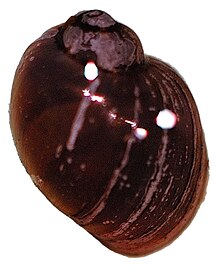Bulinus
| Bulinus | |
|---|---|

| |
| A live individual of Bulinus wrighti | |
| Scientific classification | |
| Domain: | Eukaryota |
| Kingdom: | Animalia |
| Phylum: | Mollusca |
| Class: | Gastropoda |
| Subclass: | Heterobranchia |
| Superorder: | Hygrophila |
| Family: | Planorbidae |
| Subfamily: | Bulininae |
| Tribe: | Bulinini |
| Genus: | Bulinus O. F. Müller, 1781[1] |
| Diversity[2] | |
| 37 extant species, | |
| Synonyms[3] | |
| |
Bulinus is a
This genus is medically important because several species of Bulinus function as intermediate hosts for the schistosomiasis blood fluke.[6]
Taxonomy
Miocene genus Kosovia was synonymized Bulinus in 2017.[3]
Distribution
These snails are widespread in Africa including Madagascar[7] and the Middle East.[8]
This genus has not yet become established in the USA, but it is considered to represent a potentially serious threat as a pest, an invasive species which could negatively affect agriculture, natural ecosystems, human health or commerce. Therefore it has been suggested that this species be given top national quarantine significance in the USA.[9]
Shell description
The shell of species in the genus Bulinus is sinistral. It has a very large body whorl and a small spire.
Species

Species within the genus Bulinus have been placed into four
There are 37[2] (or 38 species when the Bulinus mutandensis is recognized as a separate species) species within the genus Bulinus including:
Bulinus africanus group - 10 species
- Bulinus abyssinicus (Martens, 1866)[10]
- Bulinus africanus (Krauss, 1848)[6][10]
- Bulinus globosus (Morelet, 1866)[6][10]
- Bulinus hightoni Brown & Wright, 1978[10]
- Bulinus jousseaumei (Dautzenberg, 1890)[10]
- Bulinus nasutus (Martens, 1879)[6][10]
- Bulinus obtusispira (Smith, 1882)[10]
- Bulinus obtusus Mandahl-Barth, 1973[10]
- Bulinus ugandae Mandahl-Barth, 1954[10]
- Bulinus umbilicatus Mandahl-Barth, 1973[10]
Bulinus forskalii group - 11 species
- Bulinus barthi Jelnes, 1979[6][10]
- Bulinus bavayi (Dautzenberg, 1894)[10]
- Bulinus beccarii (Paladilhe, 1872)[10]
- Bulinus browni Jelnes, 1979[10]
- Bulinus camerunensis Mandahl-Barth, 1957[6][10]
- Bulinus canescens (Morelet, 1868)[10][11]
- Bulinus cernicus (Morelet, 1867)[6][10]
- Bulinus crystallinus (Morelet, 1868)[10]
- Bulinus forskalii (Ehrenberg, 1831)[6][10]
- Bulinus scalaris (Dunker, 1845)[10]
- Bulinus senegalensis Müller, 1781 - the type species of the genus[10]
Bulinus reticulatus group - 2 species
- Bulinus reticulatus Mandahl-Barth, 1954[10][12][6]
- Bulinus wrighti Mandahl-Barth, 1965[6][10]
Bulinus truncatus/tropicus complex - 14-15 species
- Bulinus angolensis (Morelet, 1866)[10]
- Bulinus depressus Haas, 1936[10]
- Bulinus hexaploidus Burch, 1972[10]
- Bulinus liratus (Tristram, 1863)[10]
- Bulinus mutandensis Preston, 1913[13]
- Bulinus natalensis (Küster, 1841)[10][14][6]
- Bulinus nyassanus (E. A. Smith, 1877)[6][10]
- Bulinus octoploidus Burch, 1972[10]
- Bulinus permembranaceus (Preston, 1912)[10]
- Bulinus succinoides (E. A. Smith, 1877)[10]
- Bulinus transversalis (Martens, 1897)[10]
- Bulinus trigonus (Martens, 1892)[10]
- Bulinus tropicus (Krauss, 1848)[6][10]
- Bulinus truncatus (Audouin, 1827)[6][10]
- Bulinus yemenensis Paggi et al., 1978[10]
other
- Bulinus rubellus Broderip 1832
- † Bulinus bouei (Pavlović, 1931) - from late Miocene[3]
- † Bulinus corici Harzhauser & Neubauer in Harzhauser et al., 2012 - from middle Miocene[3]
- † Bulinus matejici (Pavlović, 1931) - from middle Miocene[3]
- † Bulinus ornatus (Pavlović, 1931) - from late Miocene[3]
- † Bulinus pavlovici (Atanacković, 1959) - from late Miocene[3]
- † Bulinus stevanovici (Atanacković, 1959) - late Miocene[3]
- † Bulinus striatus (Milošević, 1978) - late Miocene[3]
References
This article incorporates CC-BY-2.5 text from the reference[6]
- ^ Müller O. F. 1781. Geschichte der Perlen-Blasen. Der Naturforscher 15: 1-20, Tab. I [= 1]. Halle.
- ^ a b Characterisation of Bulinus Archived 28 March 2007 at the Wayback Machine. Accessed 31 December 2008.
- ^ .
- ^ Atanacković, M (1959). "Pliocène du Bassin de Kosovo (Serbie méridionale)". Geološki Glasnik. 3: 257–377.
- ^ MolluscaBase eds. (2020). MolluscaBase. Bulinus O. F. Müller, 1781. Accessed through: World Register of Marine Species at: http://www.marinespecies.org/aphia.php?p=taxdetails&id=224352 on 2020-06-27
- ^ PMID 18544153.
- S2CID 21584714.
- S2CID 85182925.
- ^ Cowie R. H., Dillon R. T., Robinson D. G. & Smith J. W. (2009). "Alien non-marine snails and slugs of priority quarantine importance in the United States: A preliminary risk assessment". American Malacological Bulletin 27: 113-132. PDF Archived 16 June 2016 at the Wayback Machine.
- ^ ISBN 0-7484-0026-5
- ^ Brown D. S. (1996). Bulinus canescens. 2006 IUCN Red List of Threatened Species. Archived 27 June 2014 at the Wayback Machine Retrieved 6 August 2007.
- ^ Appleton C., Lange C. N., Kristensen T. K., Stensgaard A-S. & Van Damme D. (2009). Bulinus reticulatus. In: IUCN 2010. IUCN Red List of Threatened Species. Version 2010.4. <www.iucnredlist.org>. Retrieved 3 December 2010.
- ^ Kyambadde R. (2004). Bulinus mutandensis. 2006 IUCN Red List of Threatened Species. Archived 27 June 2014 at the Wayback Machine Retrieved 6 August 2007.
- ^ Curtis B., Jørgensen A., Kristensen T. K., Stensgaard A-S. & Van Damme D. (2009). Bulinus natalensis. In: IUCN 2010. IUCN Red List of Threatened Species. Version 2010.4. <www.iucnredlist.org>. Retrieved 3 December 2010.
